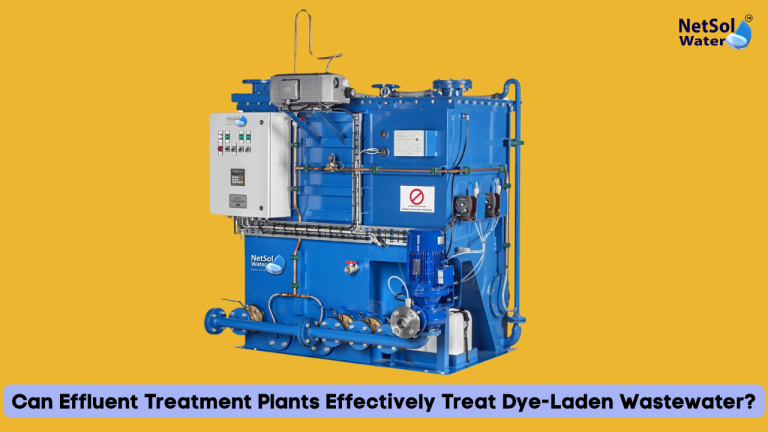
Dyes are used in huge quantities by textile factories and a range of other production units to color their manufactured goods. Although dyes improve the appearance of products, the waste from the process may be filled with toxic substances. If dye-containing water is not treated correctly, it may cause serious environmental pollution. The question is, can effluent treatment plants effectively treat dye-laden wastewater? In this blog, we will focus on how pollution from dyes harms water, the difficulties this brings and how effluent treatment plants manage and clean up this wastewater. in this blog we will discuss about the Can ETP Plant Effectively Treat Dye-Laden Wastewater.
What Is Dye-Laden Wastewater?
Water polluted with dyes and chemicals from the textile, leather tanning, paper and plastics industries is referred to as dye-laden wastewater. Because these dyes are hard to break down, they usually remain in nature for a very long time. When left untreated, wastewater can lead to color pollution in the water, reduce incoming sunlight and poison both plants and animals living there.
Challenges in Treating Dye-Laden Wastewater
It is challenging to treat wastewater loaded with dyes because:
1) Persistence of Colors: Dyes are designed to be stable and resistant to degradation by sunlight or microorganisms.
2) Toxic Chemicals: Some dyes contain toxic chemicals and heavy metals that are poisonous to wildlife and humans.
3) High COD: Dye wastewater usually has a high degree of organic pollutants.
4) Resistance to Biological Treatment: The majority of dyes are resistant to degradation in traditional biological treatment.
These issues are such that simply passing dye-charged wastewater through the regular treatment may not remove all harmful substances.
How Effluent Treatment Plants Successfully Treat Dye-Laden Wastewater
With a combination of certain advanced approaches, effluent treatment plants effectively treat dye-laden wastewater and remove color, dangerous chemicals and toxins.
1) Pre-Treatment
Dye-containing wastewater is usually treated in preliminary ways such as with screening and sedimentation, before being allowed into the main treatment process. They separate grinding particles and dirt to reduce the risk of clogging and turbidity, so other treatment can follow.
2) Coagulation and Flocculation
A coagulant is a chemical that is added to the wastewater as a coagulation treatment. They combine small dye particles, bringing a range of contaminants together. As a result, all of them aggregate into larger bundles known as flocs. A result of flocs settling is that both color and solids in the water are reduced.
3) Advanced Oxidation Processes (AOPs)
As these dyes are not easily broken down, most ETPs utilize ozone, UV light or Fenton’s reagent to make dye molecules more degradable. The oxidation of dye molecules produces molecules that can react fast, making them much safer.
4) Biological Treatment
In some cases, specially adapted bacteria and fungi can degrade some dyes. Biologic treatment tanks in ETPs use such microbes to further eliminate organic load and toxins.
5) Adsorption and Filtration
Activated carbon or other adsorbents can be utilized for the adsorption of remaining dye molecules. Ultrafiltration or reverse osmosis membrane filtration techniques can also be utilized for the removal of dissolved solids and dyes to obtain very pure water.
6) Sludge Management
The treatment produces sludge with concentrated dyes and chemicals. Proper handling and disposal of the sludge provide assurance that the sludge is not released to soil or water.
Benefits of Using ETPs for Dye Wastewater
1) Protection of the Environment: Removal of dyes and toxic chemicals prevents water contamination and protects aquatic life.
2) Compliance with Regulations: The majority of countries have strict discharge regulations for dyes. ETPs help industries achieve these regulatory compliance requirements.
3) Reuse of Water: Treated water can be recovered and reused in industrial applications, reducing the need for fresh water.
4) Health Safety: Treated dye wastewater reduces the hazard to workers and neighborhood communities by reducing contact with harmful chemicals.
Conclusion
Effluent treatment plants effectively treat dye-laden wastewater by using a mixture of chemical, physical and biological methods that are designed for the unique challenge of dyes. Even though treating dye wastewater requires special care and advanced resources, modern ETPs do an excellent job removing color, poisons and impurities, allowing industries to take care of the environment without breaching laws. Treatment plants that are designed and run correctly are essential for making wastewater containing dyes safe to either release or reuse. So when you search the Can ETP Plant Effectively Treat Dye-Laden Wastewater the answer is Yes, effluent treatment plants (ETPs) can effectively treat dye-laden wastewater using a variety of technologies to remove or degrade the dyes. Modern wastewater treatment technologies can achieve up to 90% dye removal.
Do you need an advice or assistance on selecting the best water and waste water treatment unit? We have solutions for all your problems!
Let us know your problem, our experts will make sure that it goes away.
For an assistance or related query,
Call on +91-9650608473 Or write us at enquiry@netsolwater.com
